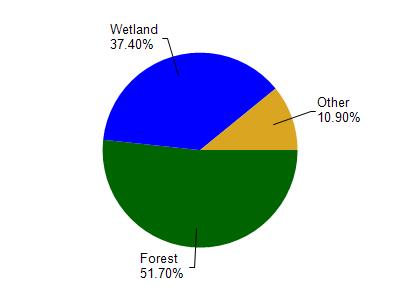Price
No
Yes
No
Fish and Aquatic Life
Overview
The Elk River supports a good warm water sport fishery and is heavily used. The
upstream part of the Elk River to the Musser Flowage is classified as a Class III trout
stream. but is affected by beaver. Some small farms lie along the river between Musser
Flowage and Duroy Lake, some small farms are located along the river. Once the Elk
River enters the Phillips chain of lakes, point sources become important, due to
historical and continuing discharge to Elk Lake by Phillips Wastewater Treatment Plant
and the Phillips Plating Corporation. The Elk River is an important tributary to the
South Fork of the Flambeau River.
Work in the 1970s and 1980s documented sediments contaminated by metals in Elk
Lake. The study noted phytoplankton and benthic macroinvertebrates accumulated
metals. However, this did not appear to extend up the food chain to fish. Metals have
also been transported downstream in the Elk River system, where they have been found
at elevated levels in the sediments in Lac Sault Dore (Smith 1983)
Little endangered resource inventory work has been done in this watershed. The Elk
River, as a major tributary to the South Fork of the Flambeau River, is important to
downstream endangered resources in the Flambeau.
Date 1996
Author Aquatic Biologist
Condition
Wisconsin has over 84,000 miles of streams, 15,000 lakes and milllions of acres of wetlands. Assessing the condition of this vast amount of water is challenging. The state's water monitoring program uses a media-based, cross-program approach to analyze water condition. An updated monitoring strategy (2015-2020) is now available. Compliance with Clean Water Act fishable, swimmable standards are located in the Executive Summary of Water Condition in 2018. See also the 'monitoring and projects' tab.
Reports
Recommendations
Citizen-Based Stream Monitoring
Collect chemical, physical, and/or biological water quality data to assess the current overall stream health. The data can inform management decisions and may be used to identify impaired waters for biennial lists.
Citizen-Based Stream Monitoring
Collect chemical, physical, and/or biological water quality data to assess the current overall stream health. The data can inform management decisions and may be used to identify impaired waters for biennial lists.
Protect Riparian or Shorelands
Price County is sponsoring a project to restore 250 feet of shoreline habitat along the Elk River. There is an unstable 25 foot face that is actively eroding and needs to be stabilized. Fish- wildlife habitat and water quality will be improved. Project goals: 1) Reduce sediment and nutrient delivery; 2) Reduce instream sedimentation to improve fish spawning habitat; 3) Restore shore land habitat for wildlife; 4) Improve water quality; 5) Protect existing resources.
Restore Riparian Habitat
Price County is sponsoring a project to restore 250 feet of shoreline habitat along the Elk River. There is an unstable 25 foot face that is actively eroding and needs to be stabilized. Fish, wildlife habitat and water quality will be improved. Project goals: 1) Reduce sediment and nutrient delivery; 2) Reduce instream sedimentation to improve fish spawning habitat; 3) Restore shore land habitat for wildlife; 4) Improve water quality; 5) Protect existing resources.
Management Goals
Wisconsin's Water Quality Standards provide qualitative and quantitative goals for waters that are protective of Fishable, Swimmable conditions [Learn more]. Waters that do not meet water quality standards are considered impaired and restoration actions are planned and carried out until the water is once again fishable and swimmable
Management goals can include creation or implementation of a Total Maximum Daily Load analysis, a Nine Key Element Plan, or other restoration work, education and outreach and more. If specific recommendations exist for this water, they will be displayed below online.
Monitoring
Monitoring the condition of a river, stream, or lake includes gathering physical, chemical, biological, and habitat data. Comprehensive studies often gather all these parameters in great detail, while lighter assessment events will involve sampling physical, chemical and biological data such as macroinvertebrates. Aquatic macroinvertebrates and fish communities integrate watershed or catchment condition, providing great insight into overall ecosystem health. Chemical and habitat parameters tell researchers more about human induced problems including contaminated runoff, point source dischargers, or habitat issues that foster or limit the potential of aquatic communities to thrive in a given area. Wisconsin's Water Monitoring Strategy was recenty updated.
Grants and Management Projects
Monitoring Projects
| WBIC | Official Waterbody Name | Station ID | Station Name | Earliest Fieldwork Date | Latest Fieldwork Date | View Station | View Data |
|---|
| 2236500 | Elk River | 10015233 | Elk River | | | Map | Data |
| 2236500 | Elk River | 10041051 | Elk River 30m US CTH H | 10/24/2013 | 1/1/2015 | Map | Data |
| 2236500 | Elk River | 513122 | Elk River at Hwy H | 7/18/1973 | 2/11/1975 | Map | Data |
|

Watershed Characteristics
Elk River is located in the Elk River watershed which is 261.12 mi². Land use in the watershed is primarily forest (51.70%), wetland (37.40%) and a mix of grassland (4.70%) and other uses (6.20%). This watershed has 254.00 stream miles, 2,883.84 lake acres and 49,382.72 wetland acres.
Nonpoint Source Characteristics
This watershed is ranked Not Ranked for runoff impacts on streams, Low for runoff impacts on lakes and Low for runoff impacts on groundwater and therefore has an overall rank of Low. This value can be used in ranking the watershed or individual waterbodies for grant funding under state and county programs.However, all waters are affected by diffuse pollutant sources regardless of initial water quality. Applications for specific runoff projects under state or county grant programs may be pursued. For more information, go to surface water program grants.